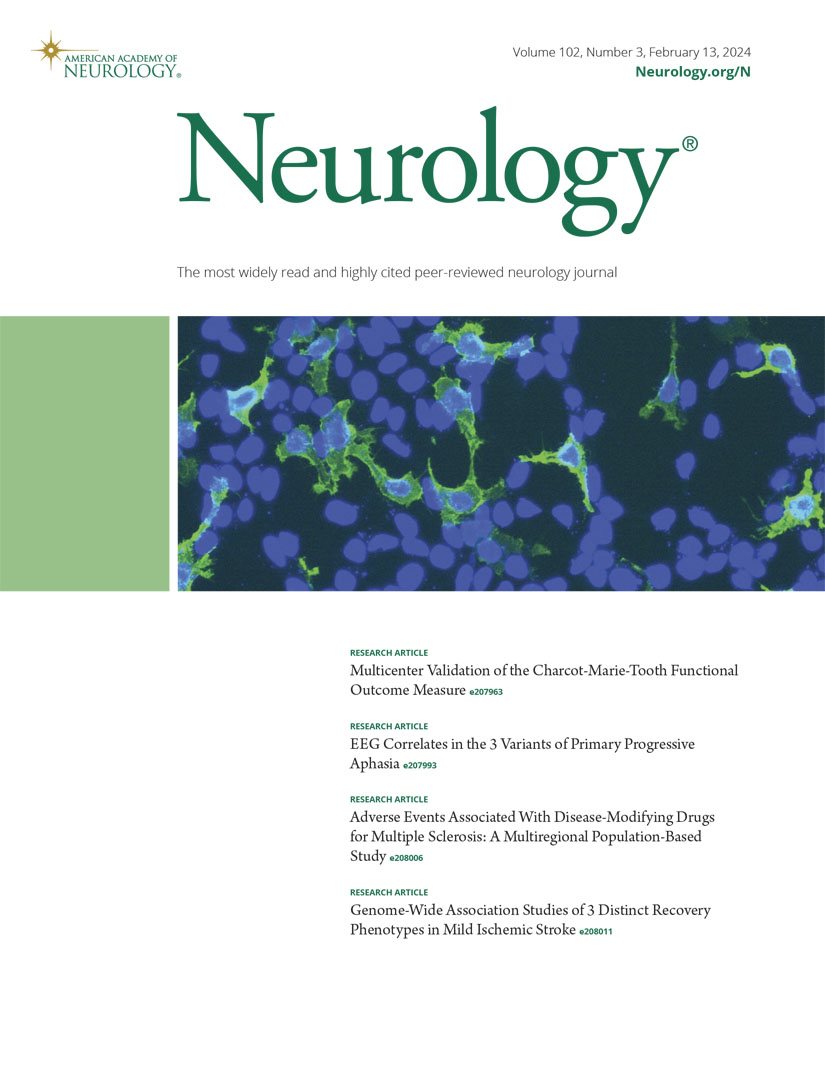Focal Hypoperfusion on Baseline Perfusion-Weighted MRI and the Risk of Subsequent Cerebrovascular Events in Patients With TIA.
IF 8.5
1区 医学
Q1 CLINICAL NEUROLOGY
引用次数: 0
Abstract
BACKGROUND AND OBJECTIVES While MRI is known to be crucial for TIA workup, the benefit of perfusion-weighted imaging (PWI) is underexplored. We aimed to assess the association between focal hypoperfusion on baseline PWI MRI and the long-term incidence of subsequent acute ischemic stroke (AIS) after TIA. METHODS Consecutive patients with TIA who underwent baseline PWI MRI as part of their emergency consultation between January 2015 and December 2019 were retrospectively identified. For study inclusion, both a time-based (symptom duration <24 hours) and an imaging-based (no signs of ischemia on diffusion-weighted imaging) TIA definition were applied. Long-term incidences of AIS after TIA were identified based on follow-up reports. Associations between focal hypoperfusion and subsequent AIS were assessed using Cox regression models adjusted for predefined predictors of stroke occurrence including symptomatic extracranial or intracranial stenosis. In subgroup analyses, we aimed to determine effects of focal hypoperfusion within vs outside the expected TIA territory, defined as a brain region potentially correlating with TIA symptoms. RESULTS Of 1,359 eligible patients with TIA, 1,075 with PWI MRI (79%) were included (median age 70 years, 46% female). Focal hypoperfusion was identified in 211 patients (20%); in 116 of 211 (55%), hypoperfusion occurred within the expected TIA territory. The median time from symptom onset to imaging was 233 minutes (interquartile range [IQR] 131-632) for patients with focal hypoperfusion vs 229 minutes [IQR 140-441] for patients without (p = 0.42). Focal hypoperfusion was associated with a higher incidence of AIS (adjusted hazard ratio [aHR] 2.13; 95% CI 1.19-3.80). While this was observed for focal hypoperfusion within the expected TIA territory (aHR 3.95; 95% CI 2.05-7.60), there was no such association in case of focal hypoperfusion outside the expected TIA territory (aHR 0.72; 95% CI 0.25-2.03). DISCUSSION Focal hypoperfusion on acute PWI MRI was found in 1 in 5 patients with TIA. It was associated with a higher incidence of AIS during long-term follow-up, especially when within the expected TIA territory. Further research is needed to clarify the predictive value of focal hypoperfusion in relation to the incidence of AIS after TIA and to explore potential therapeutic implications.基线灌注加权MRI的局灶性灌注不足与TIA患者随后脑血管事件的风险。
背景和目的虽然MRI在TIA检查中至关重要,但灌注加权成像(PWI)的益处尚未得到充分探讨。我们的目的是评估基线PWI MRI局灶性灌注不足与TIA后急性缺血性卒中(AIS)的长期发生率之间的关系。方法回顾性分析2015年1月至2019年12月期间连续接受基线PWI MRI作为急诊会诊的TIA患者。纳入研究时,采用基于时间(症状持续时间<24小时)和基于成像(弥散加权成像未见缺血迹象)的TIA定义。根据随访报告确定TIA后AIS的长期发病率。使用Cox回归模型评估局灶性灌注不足与随后AIS之间的关联,该模型校正了脑卒中发生的预定义预测因子,包括症状性颅外或颅内狭窄。在亚组分析中,我们的目的是确定局灶性灌注不足在预期TIA区域内与外的影响,TIA区域被定义为与TIA症状潜在相关的大脑区域。结果在1359例符合条件的TIA患者中,包括1075例PWI MRI(79%)(中位年龄70岁,46%为女性)。211例(20%)发现局灶性灌注不足;211例患者中116例(55%)在预期TIA范围内发生灌注不足。局灶性灌注不足患者从症状发作到显像的中位时间为233分钟(四分位数范围[IQR] 131-632),而无局灶性灌注不足患者为229分钟[IQR] 140-441] (p = 0.42)。局灶性灌注不足与AIS的高发生率相关(校正风险比[aHR] 2.13;95% ci 1.19-3.80)。虽然在预期TIA范围内观察到局灶性灌注不足(aHR 3.95;95% CI 2.05-7.60),在预期TIA范围之外的局灶性灌注不足的情况下,没有这种关联(aHR 0.72;95% ci 0.25-2.03)。讨论局灶性灌注不足在急性PWI MRI上发现1 / 5的TIA患者。在长期随访期间,特别是在预期的TIA范围内,它与AIS的发生率较高有关。需要进一步的研究来明确局灶性灌注不足对TIA后AIS发病率的预测价值,并探讨潜在的治疗意义。
本文章由计算机程序翻译,如有差异,请以英文原文为准。
求助全文
约1分钟内获得全文
求助全文
来源期刊

Neurology
医学-临床神经学
CiteScore
12.20
自引率
4.00%
发文量
1973
审稿时长
2-3 weeks
期刊介绍:
Neurology, the official journal of the American Academy of Neurology, aspires to be the premier peer-reviewed journal for clinical neurology research. Its mission is to publish exceptional peer-reviewed original research articles, editorials, and reviews to improve patient care, education, clinical research, and professionalism in neurology.
As the leading clinical neurology journal worldwide, Neurology targets physicians specializing in nervous system diseases and conditions. It aims to advance the field by presenting new basic and clinical research that influences neurological practice. The journal is a leading source of cutting-edge, peer-reviewed information for the neurology community worldwide. Editorial content includes Research, Clinical/Scientific Notes, Views, Historical Neurology, NeuroImages, Humanities, Letters, and position papers from the American Academy of Neurology. The online version is considered the definitive version, encompassing all available content.
Neurology is indexed in prestigious databases such as MEDLINE/PubMed, Embase, Scopus, Biological Abstracts®, PsycINFO®, Current Contents®, Web of Science®, CrossRef, and Google Scholar.
 求助内容:
求助内容: 应助结果提醒方式:
应助结果提醒方式:


